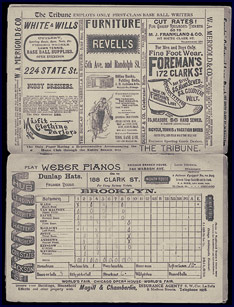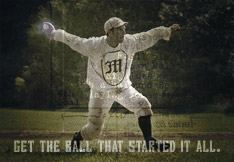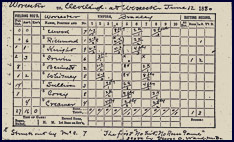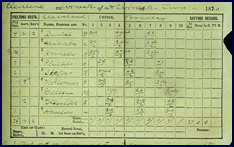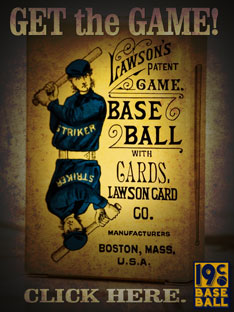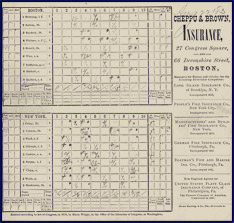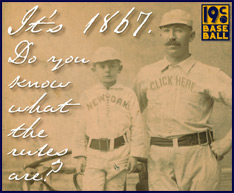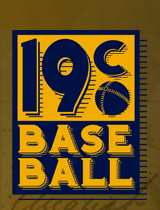History of the Hit Batsman (Continued)

he National League made no changes to the rule regarding the definition and outcome of a hit batsman. The fine given to the pitcher also remained the same and six balls were now needed to give the batter his first. During the Union Association's lone season of 1884, the rule regarding the hit batsman was the same as the National League's as was the number of called balls needed for the batter to advance to first.
The American Association removed the phrase "hit solidly" from "The Game" section that allowed the base-runner to advance one base without being put out (providing he did so on the run). The 1885 rules stated, "If while he be batsman, he be hit by a ball from the Pitcher when he evidently cannot avoid the same."
The National League made no changes regarding the rule or fines.
The American Association, for the third straight year amended the hit batsman rule for the 1886 season. The rule listed in "The Game" section and under the portion that allowed the base-runner to advance one base without being put out (providing he did so on the run), now stated, "If, while he be a batsman, he be hit by a ball from the Pitcher, unless in the opinion of the umpire he intentionally permits himself to be hit." Six balls were now needed for a batter to take his first.
The National League again made no changes to the rule or fine amount, however they raised the number of balls from six to seven.
When the National League and the American Association agreed to play under the same rules for the 1887 season the AA's hit batsman rule from 1886 was amended. The rule, listed under the heading "When a Batsman becomes a Base Runner" was written as follows, "If when he be a batsman, his person or clothing be hit by a ball from the pitcher, unless - in the opinion of the Umpire - he intentionally permits himself to be so hit." As in the American Association in 1885, a ball was assessed to the pitcher if the pitched ball hit the batsman bat without being swung at, hit the batsman or the batsman clothing without an attempt to avoid the ball or hit the umpire or the umpire's clothing before passing the catcher. Five balls allowed the batter first base and subsequently any base runner forced to vacate their base was entitled to do so. There was no mention of specific fines given to pitchers who hit batsman intentionally.
In 1889 the balls and strikes were adjusted for the last time and it took four balls to give the batter his first and he was out after three strikes, called or swinging.
In 1890 the Players National League was formed and used the exact same rules regarding the hit batsman as the NL and AA did for the 1890 season, which was the same as the 1887 rules except that four balls, in both leagues, gave the batter his first base. The Players League would not play a second season.
In Spalding's Base Ball Guide 1892, The hit batsman rule was listed under the "Base Running Rules; When the Batsman Becomes a Base Runner," and written as follows, "If, while he be a batsman without making an attempt to strike his person—excepting hands or forearm, which makes it a dead ball—or clothing be hit by a ball from the Pitcher, unless—in the opinion of the Umpire—he intentionally permits himself to be so hit." An explanation of the change in the rule stated that it was designed to stop batsman from letting the ball hit the bat and claim it hit their arm or hand.
David Nemec explains, "The (Curt) Welch amendment to the HBP rule in 1892 was never officially called that but emanated from what were considered "cheap" bases received on HBPs (Hit By Pitch), with Welch viewed as the leading culprit. With the bases empty Welch would often fake a bunt drawing the catcher out from behind the plate to field it and leave the poor umpire unprotected—catchers, as you know, at that time played back with the bases empty and came rushing out as the pitch was delivered if a bunt seemed in the offing—and then Welch would pretend to duck away from the pitch and manage to have it either graze his arm or else, if it was inside, stick up his hand, as if to protect himself. Welch's maneuver would also of course act to save the ump from being hit by the pitch, making him all the more inclined to give Welch his base."
No HBP was credited for being struck on the hand or forearm and became the rule (see the 1892 Spalding Guide for the exact wording of the new rule) until the old rule was restored in 1897, although there were almost yearly debates at NL meetings as to whether the new rule was a good one. The pivotal incident occurred on 5/12/96 at Louisville (Eclipse Park II) when Tom Daly (Brooklyn Bridegrooms) was hit on the wrist by a Chick Fraser (Louisville Colonels) pitch and had to pretend he was hit on the shoulder in order to get his base. After the game it emerged that Daly's wrist had been broken by the pitch, a ludicrous development that led to a groundswell to rescind the Welch amendment and restore the old rule (see the 1897 Guide).
As Mr. Nemec stated the rule was changed for the 1897 season, under the same heading as 1894 and was written as follows, "If, while he be a batsman, without making any attempt to strike at the ball, his person or clothing be hit by a ball from the pitcher; unless, in the opinion of the umpire, he plainly avoids making any effort to get out of the way of the ball from the pitcher, and thereby permits himself to be so hit." This rule did not change again in the 19th century.
The pitchers and batters each used the hit batsman to their advantage and the rules makers attempted to not allow one to have and advantage over the other. This theme was a constant battle the rules makers fought throughout the 19th century.
Editor's Notes:
The rules listed in Beadle's Dime Base Ball Player from 1860 - 1862 and 1864 - 1881 were the amateur rules for baseball. DeWitt's Base Ball Guide, 1869 - 1885 (for this purpose 1871 - 1885) and Spalding's Official Base Ball Guide, 1877 - 1900, listed the professional playing rules.
19th century baseball expert, author and historian David Nemec graciously contributed to this article.
The Rules: History of the Strike ![]()
The Rules of the Game: A Compilation of the Rules of Baseball 1845–1900 ![]()
